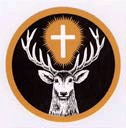|
Old Kilcullen Effigy: Ballymore Eustace
The Old Kilcullen effigy (now at Ballymore Eustace) was originally in the church at New Abbey, probably on an altar tomb which has disappeared. By 1781 it had been moved outside and was then leaning against the wall at the south-west corner of the nave and already much discoloured. It suffered during the fighting at Kilcullen in 1798, and was again moved and is said to have been used at one period as a paving slab under a pump. In about 1850 it was taken for safe keeping by Sir Erasmus Dixon Borrowes, Bart., to his residence at Barretstown Castle just north of Ballymore Eustace. He had the surface cleaned, perhaps with excessive zeal. On the sale of the Castle by his son in 1919 the effigy was moved to its present position in Ballymore Eustace Protestant church. It represents a knight in chain-mail but with gauntlets, brassets and jambs of plate. The head is now badly damaged, but originally had a conical helm, on the front of which the Eustace stag could be distinguished as late as the mid-eighteenth century. The work is very crude and the groups of links in the chain-mail are carved too large. It is unfortunately impossible to identity the effigy with certainty, but I personally have little doubt that it represents Sir Edward Eustace of Castlemartin who died in 1454. This was before the Castlemartin Chapel had been built, and he might well have been buried at Old Kilcullen. The armour appears to resemble strongly that of the effigy in St. Werburgh’s Church, Dublin, known to be either that of 7th Earl of Kildare who 1477 died, or of the 6th Earl who died 1427. On the other hand Mr. John Hunt who is an authority on Irish effigies, dates it as about 1300 or even later, it would seem that although body-armour of plate was in general use in England, and is in fact worn by the Portlester effigies, the habergeon or jack of mail was preferred as late as 1500, or even later, in Ireland, for actual fighting as it was found more suited to local conditions. If dated as late as this the figure might well be that of the 1st Viscount. He saw far more active service than his uncle Portlester, and might have worn more useful, if less fashionable, armour.
It will be convenient here to deal with the other two known Eustace effigies, which both date from roughly the same period as those just described. These pages © Ronald Eustice, 2007
|
